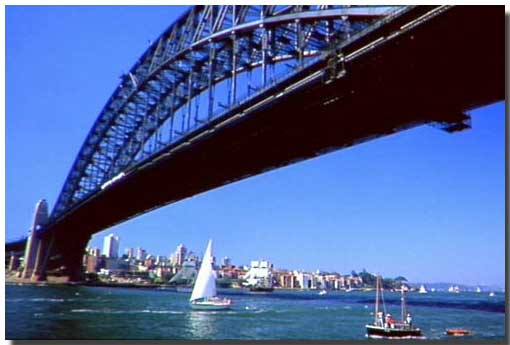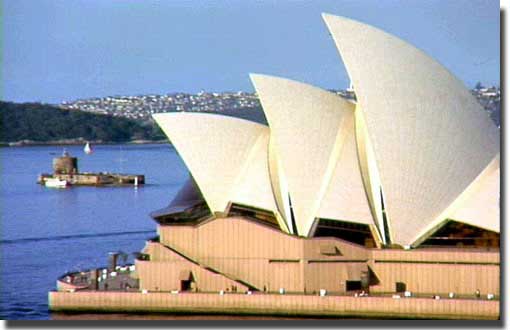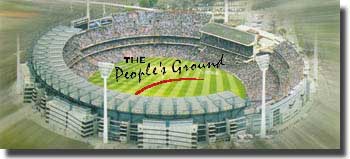|
Four Australian Icons
Introduction With each photograph is a brief description of the specific Icon displayed. Sydney Harbour Bridge  The top of the arch is 134 metres above sea level, and the clearance for shipping is 43 metres. The first time I ever sailed beneath the bridge was in September 1939, in the cruiser HMAS Australia, and we were proceeding up to Cockatoo Dock. Her mainmast was too tall to clear the lowest part of the bridge, and about 15 feet needed to be struck from the mainmast so we could sail beneath this mighty structure. I recall on that occasion, standing on her quarterdeck, gazing up at the mainmast and watching the ship creep slowly towards the lowest part of the roadway slung under the great arch of the bridge, visually it looked as if we would not make it, then at the last moment we glided slowly beneath the bridge to clear by a few feet. The arch weighs in at 39,000 tonnes whilst the total steelwork weighs some 59,000 tonnes. Tenders were called by the Government of New South Wales, in 1922, to build this bridge, and 6 companies around the world put in their bids, but the successful one came from Dorman Long and Company, Middleborough in England. On the 24th. of March 1924 the contract was let to them for 4,217,721 Pounds, 11 Shillings and 10 Pence Australian. The general design of this bridge is credited to Dr J.J.C.Bradfield and officers of the NSW Department of Public Works. The foundations were dug to a depth of 12.2 metres, and the four pylons which anchor the main arch are 89 metres high, built from concrete, and faced with granite quarried near Moruyu, 300 kilometers south of Sydney. These granite blocks, all numbered, measured 18, 000 cubic metres. In constructing the bridge, two half arches were built, one each from the north and south shores. These were each supported by 129 cables anchored underground through tunnels. As Sydneysiders awoke on the morning of the 20th. of August 1930, there was great excitement abroad, the two arches had been joined as one, at 10 PM. during the previous night. On the 21st. of January 1932, the last of 6 Million Australian made rivets were driven through the steel deck to complete this ambitious work. The NSW Premier, the Honourable J.T.Lang, was to officially open the bridge on Saturday the 19th. of March 1932 before an estimated crowd of about 1 Million on lookers, but before he could cut the ceremonial ribbon, up galloped a member from the New Guard, a para military group, with Captain Francis de Groot, slashing the ribbon with his drawn sword. This act is now part of Australia's Folk Lore. The Bridge Roadway or Deck Traffic Statistics By 1989, this had grown to 182,024 vehicles daily. In 1992, a tunnel beneath the harbour was opened, and this siphoned off something like 44,000 vehicles using the bridge each day. The first 500,000 crossings took 33 years to be achieved, the second 500,000 crossings only took another 11 yeras. Toll to use the bridge The current toll is $A 3. 00. Conclusion The Sydney Opera House  During it's construction in 1966, with arguments about cost blowouts, interior design, and the NSW Government withholding progressive payments, Utzon resigned from the project. It was completed by NSW Government departments at a total cost of A$ 102 Million, and hosts about 3,000 events annually to an audience that adds up to 2 million customers. It measures 185 metres in length by 120 metres wide. The first performance here, was the Australian Opera's: War and Peace. The unusual sails that make up the roof, took one million separate tiles to sheath them. As you move up Sydney Harbour by ferry or by ship, the Opera House comes into view, backdropped by the Sydney Harbour Bridge , they are two magical structures, that no visitor to Sydney for the first time is ever likely to forget. Uluru or Ayer's Rock  The circumference of The Rock, is 9.4 kilometers and you will need some 3 hours if you want to walk right round this incredible formation. I only visited it for my first time last year, when Denise and I flew in to Alice Springs from Broome, and we made the almost 1,000 kilometer return journey by bus in one long, long day trip that lasted about 18 hours. This Icon squats in the desert, where the annual rainfall is only 200-250 mm, and the night winter temperature can fall to -8 degrees C. in complete contrast to a summer's day temperature which may reach 47 degrees C. The aboriginal people who claim this area as their traditional land, have been in occupation for some 10,000 years, and in 1985, the Commonwealth of Australia handed back Uluru to it's traditional owners. At dawn and again at sunset, this magnificant monolith is a wonderful spectacle as the sun rises or sets, and the many changing hues to be observed are a great sight, it must be one of the most photographed sites in my country. I am sure that photographic film suppliers from around the world, are truly grateful that it stands so proudly here in the Red Centre of Australia, begging to be recorded on the camera of all who visit, and enjoy Uluru. Melbourne Cricket Ground  The Melbourne Cricket Club was founded back in 1838, when the Port Phillip District boasted but 2,000 in it's population. Governor La Trobe had offered the Cricket Club three possible sites for it's home ground, one, adjacent to the present site, one near Flinders Street and Spring Street located to the west of the growing township, and the third, the Police Paddock at Richmond. This was the site chosen as it was not subjected to flooding, and is where the MCG still lives today, having taken up residence in 1853. Site for 1956 Olympic Games This ground houses the Australian Gallery of Sport, the Olympic Museum, and the Melbourne Cricket Club Cricket Museum. In 1970 at the Victorian Football League Grand Final between the Carlton and Collingwood football clubs, the record attendance at a single sporting event was set, when 121,690 fans crowded into this historic ground. However, the largest crowd ever to cram into the MCG, was on the 15th. of March 1959, when 139,000 attended to hear the American Evangalist Billy Graham preach. Ground Size and Lighting 2006 Commonwealth Games These major works are scheduled to be completed in time to stage the Commonwealth Games at this venue in 2006. The Melbourne Cricket Ground has long been a part of the Melbourne sporting public's life, and these latest renovations will ensure it stays that way in the future. |
